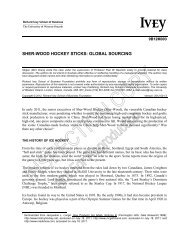foundation of canada asia pacific - Content Tagged with
foundation of canada asia pacific - Content Tagged with
foundation of canada asia pacific - Content Tagged with
Create successful ePaper yourself
Turn your PDF publications into a flip-book with our unique Google optimized e-Paper software.
THE CHALLENGE OF GLOBALIZATION<br />
Underlying the Asian crisis was a widespread lack <strong>of</strong> understanding <strong>of</strong> the extent to which<br />
globalization has changed the world. Asian countries that took advantage <strong>of</strong> the easier<br />
access to foreign capital afforded by the emergence <strong>of</strong> highly liquid global money markets<br />
neglected to put in place the safeguards needed to integrate these new capital flows<br />
into their financial systems. The message for Canadians in the Asian crisis is not that<br />
globalization is a threat, rather it requires reworked rules for trade and investment that<br />
recognize the benefits <strong>of</strong> free markets while ensuring the access to information that<br />
free markets require to avoid destabilizing shocks. In other words, markets must be<br />
structured so they can operate smoothly. Internationally, Finance Minister Paul Martin is<br />
heading up the Group <strong>of</strong> 20, which is attempting to devise new architecture for the<br />
global financial system. However, this is only one, albeit important, part <strong>of</strong> the<br />
equation. In essence, “globalization” describes the process that is changing the entire<br />
international economic system at the start <strong>of</strong> the 21st century. It has to be kept in mind<br />
in developing almost all economic policies, domestic or international. Canada has been at<br />
the forefront in adapting to globalization: our entry into NAFTA was both a recognition <strong>of</strong><br />
the inevitable integration <strong>of</strong> the North American economy and a bold — though<br />
perhaps unintentional — move to force on Canadian industry the type <strong>of</strong> rationalization<br />
required to compete in global markets. 2 As already noted, the result has been a rapid<br />
integration <strong>of</strong> our economy <strong>with</strong> that <strong>of</strong> the US. Since the advent <strong>of</strong> the Canada-US<br />
Free Trade Agreement, Canadian investment in the US has risen almost 150%; exports are<br />
up even more. The process <strong>of</strong> integration has in many cases been painful, and is far from<br />
complete. But it has left important parts <strong>of</strong> Canadian industry in a strong position to<br />
13<br />
services. By 1980, 74% <strong>of</strong> Malaysia’s manufactured exports came from its EPZs. 2 The seeds <strong>of</strong><br />
transnational manufacturing in Asia had been planted.<br />
At around the same time, a revolution was taking place in global transportation. Containerization <strong>of</strong><br />
cargoes increased speed and efficiency and reduced worldwide shipping costs. Asian exporters quickly<br />
took to containerization <strong>with</strong> the result that by the 1980s, Hong Kong and Singapore boasted the<br />
two busiest containerports in the world. While containerships were cutting shipment times across<br />
oceans, the movement <strong>of</strong> goods and people by air also took a huge step forward <strong>with</strong> the introduction<br />
<strong>of</strong> the jumbo jet — Boeing’s 747 in 1969 and the McDonnell Douglas DC-10 the following year. These<br />
two giant aircraft brought down the cost <strong>of</strong> international air travel dramatically, and made it possible<br />
to move perishable cargoes faster and more economically than ever before. It also meant pr<strong>of</strong>essional<br />
staff could travel from their head <strong>of</strong>fices to <strong>of</strong>fshore plants <strong>with</strong> relative ease and at reasonable expense.<br />
While the movement <strong>of</strong> physical goods was becoming more efficient, the transmission <strong>of</strong> information<br />
was on the threshold <strong>of</strong> a revolution. The introduction <strong>of</strong> high-capacity transoceanic co-axial cables,<br />
then satellite communications and fibre-optic links made communications across oceans or continents<br />
as easy as a call across a city. By the 1980s, conversations and data could be exchanged almost<br />
instantaneously. The advent <strong>of</strong> computer-based communications and, in 1992, the World Wide Web,<br />
forever removed distance as a barrier to the flow <strong>of</strong> information. Today an <strong>of</strong>fice in North America can<br />
monitor and manage the inventory or product flow <strong>of</strong> a plant in Penang or Shenzhen.<br />
The new ease <strong>of</strong> communications has had its most dramatic effect in financial services. Funds can be<br />
moved internationally <strong>with</strong> a few keystrokes <strong>of</strong> a computer keyboard. Buy or sell orders can be executed<br />
in a network <strong>of</strong> stock markets around the world, 24 hours a day. Whole new markets have emerged



